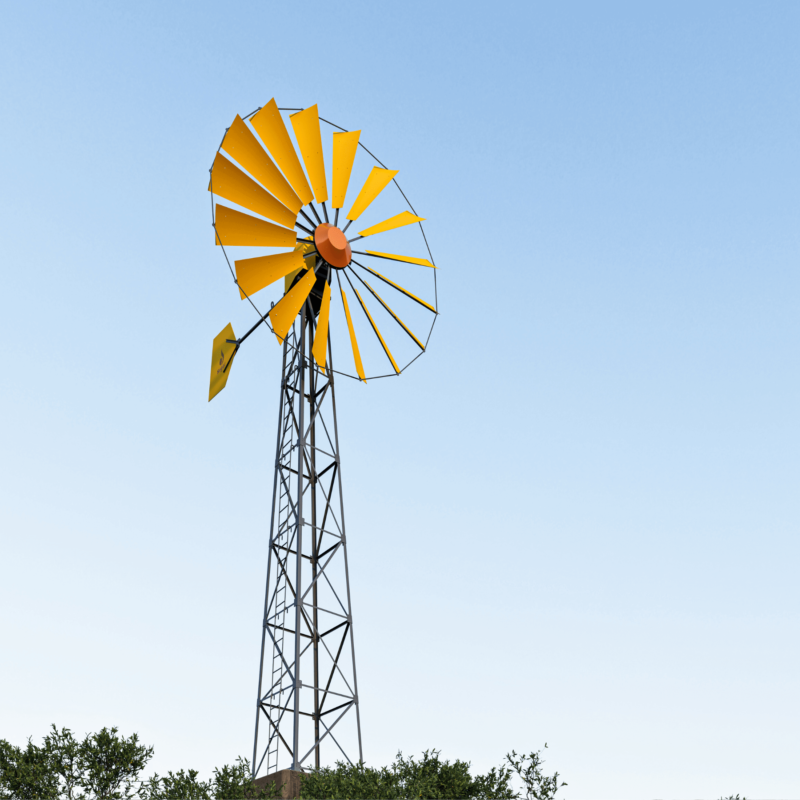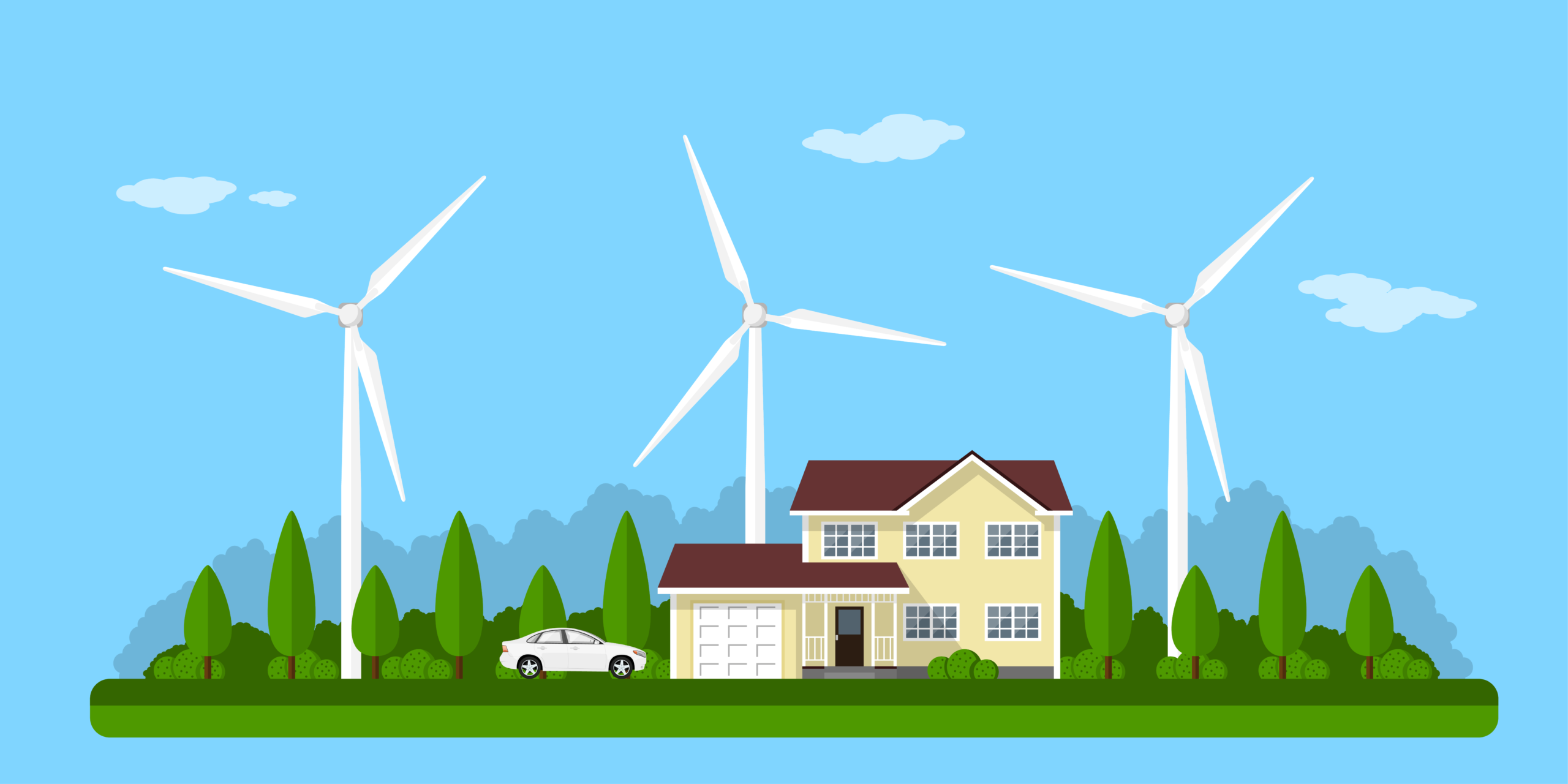Sustainable agriculture is critical to protecting our planet and leaving fertile land for future generations. In this big picture, it is crucial to reduce energy use and make the best use of natural resources. Agricultural irrigation systems with wind energy combine these two goals, offering farmers an innovative and environmentally friendly solution. 🌾💧 In this article, we explain how you can build an efficient irrigation system with the help of modern wind turbines, inspired by the windmills of ancient times. We will explore how to revitalize fields and conserve water resources using wind power.
How to Irrigate Agriculture with Wind Energy?
Wind energy-based agricultural irrigation is a method that uses renewable energy sources to irrigate agricultural fields. The Windpump is an innovative device that operates using wind energy to pump water from various sources. This system is used for various purposes such as providing clean drinking water, agricultural irrigation, and watering livestock. It offers an environmentally friendly and cost-effective solution in the long run. With the Soyut WindMill Windpump, you can reduce your agricultural irrigation costs. So, how does the wind energy-based agricultural irrigation process work? Here is a step-by-step explanation:

Windpump Installation
The first step is the installation of windpumps. Wind turbines convert wind energy into mechanical energy. They are usually placed in open areas where wind is abundant, especially near fields or farms. The size and capacity of the water pump is determined by the size of the irrigated area and the water demand.
Soyut WindMill Windpump can be easily assembled thanks to its mount-dismount structure and portable ladders. The designed carrier system and winch mechanism facilitate the transportation and assembly of parts without the need for a crane. Special connection components and anchoring plates are used for the tower legs and the water well, ensuring proper alignment during assembly.

Working Principle of Wind Water Pump
Windpump fulfills the function of drawing water from water sources with wind power. The circular motion obtained through the blades is converted into linear motion in the machine room and pumps the water. The system is effective even in light winds and can be designed in different capacities according to user needs.
Technical Specifications of Soyut WindMill WindPumps
- Blades: 16 composite blades, each 4 mm thick and 165 cm long, provide optimal performance against the wind.
- Machine Room: The gear mechanism increases torque threefold, allowing for the extraction of water from deep sources.
- Tail: Hinged structure that detects wind direction and ensures safety.
- Tower: Galvanized steel structure, 10 meters high and consisting of 6 segments.
- Pump: Rust-resistant design capable of operating at depths of up to 120 meters.
- Winch and Carrier Systems: Easy and secure assembly with a lifting capacity of up to 1000 kg.
Wind Energy and Sustainable Agriculture
According to World Bank reports, agricultural production will increase by 70% by 2050. This increase will also lead to an increase in energy demand. Wind energy stands out as a renewable energy source with high potential to meet this need. Wind power capacity worldwide has increased by about 25% in the last decade.
From History to Today: From Windmills to Modern Turbines
Windmills have been used in energy production for centuries. However, with technological innovations, the energy efficiency of modern wind turbines is much higher than that of older mills. For example, a single modern wind turbine can generate an average of 6 million kWh of electricity per year. This is equivalent to the annual electricity consumption of about 1,500 homes.
Integration of Wind Energy and Agricultural Irrigation
Wind-powered irrigation systems increase agricultural productivity by conserving water resources. Research shows that wind-powered pumps can save up to 50% more energy than conventional fossil fuel-powered pumps. This is vital for agricultural production, especially in water-scarce regions.
Practical Applications of Wind-Powered Irrigation Systems
Various examples around the world demonstrate the success of wind-powered irrigation systems. For example:
Türkiye: Türkiye'nin rüzgar enerjisi potansiyeli yüksek olan bölgelerinde, özellikle Ege ve Marmara bölgelerinde, rüzgar enerjili sulama sistemlerinin kullanımı artmaktadır. Bu sistemler, özellikle zeytin, üzüm gibi ürünlerin yetiştirildiği alanlarda su tasarrufu ve verimlilik artışı sağlamaktadır.
Avrupa: Almanya ve İspanya gibi Avrupa ülkelerinde, rüzgar enerjisi tarımsal faaliyetlerde giderek daha fazla kullanılmaktadır. İspanya'da, rüzgar enerjisi ile çalışan sulama sistemleri, özellikle kurak bölgelerde su kaynaklarının daha verimli kullanılmasını sağlamaktadır.
Çin: Çin, rüzgar enerjisi kullanımında dünya liderlerinden biridir ve bu teknolojiyi tarımsal sulamada da etkin bir şekilde kullanmaktadır. Özellikle kuzey ve kuzeybatı bölgelerinde, rüzgar enerjisiyle çalışan sulama sistemleri, su kullanım verimliliğini artırarak tarımsal üretimi desteklemektedir.
ABD: Bazı bölgelerinde rüzgar enerjisiyle çalışan sulama sistemleri, su kullanımını %30 oranında azaltmış ve tarımsal verimliliği önemli ölçüde artırmıştır. Bu sistemler, aynı zamanda uzun vadede maliyet tasarrufu sağlamaktadır.
This diversity demonstrates how wind-powered irrigation systems can be effectively applied in different climatic and geographical conditions. These systems, which both conserve water resources and provide energy efficiency, play an important role for the future of sustainable agriculture on a global scale.
Looking to the Future: The Progress of Wind Energy and Sustainable Agriculture
In the future, the integration of wind energy and sustainable agriculture will become even more important. According to the International Energy Agency, the use of renewable energy sources in the agriculture sector could double over the next decade. This integration will reduce the environmental impact of agricultural activities and contribute to more sustainable food production.
Environmental Benefits of Wind-Powered Water Pumps
Wind-powered water pumps have emerged as a significant part of sustainable agricultural practices. Their environmentally friendly features can be summarized as follows:
Low Carbon Footprint
Wind-powered water pumps have significantly lower carbon emissions compared to fossil fuel-based systems. As these pumps use renewable energy from the wind, they play an effective role in reducing greenhouse gas emissions.
Energy Efficiency
Wind energy is a natural and inexhaustible resource. Wind-powered pumps draw energy directly from the wind, minimizing losses in energy conversion. This enhances overall energy efficiency and reduces environmental impact. Agricultural irrigation is a major cost, and a one-time investment in wind energy provides a cheap, efficient, and clean energy source.
Sustainable Water Management
These pumps can be used to manage water resources more sustainably. They consume less water compared to traditional irrigation methods and help in conserving water resources. This is particularly important in regions experiencing water scarcity.
Ecological Impact
Wind-powered water pumps have minimal impact on natural habitats. These systems help maintain environmental balance without negatively affecting wildlife and plant life.
Long-Term Sustainability
Wind energy offers a sustainable path to meet future energy needs. The use of these pumps contributes to long-term environmental sustainability in the agricultural sector.
The eco-friendly features of wind-powered water pumps make them an indispensable part of modern agriculture. The widespread adoption of this technology represents a significant step in enhancing farmers' productivity while protecting the health of our planet.

Energy Conversion and Storage
The mechanical energy produced by the wind water pump is converted into electrical energy through a generator. This electrical energy can be used directly in the irrigation system or stored with the help of batteries. Energy storage ensures that irrigation can continue even when the wind is not blowing.
Integration of Irrigation System
Electrical energy is used to operate irrigation pumps. These pumps draw water from wells, reservoirs, or other water sources and direct it to the irrigation system. Wind-powered pumps can be designed to be compatible with different irrigation techniques such as drip irrigation and sprinkler systems.
Automation and Control
Advanced wind-powered irrigation systems may include automation and control mechanisms. This enables efficient management of irrigation processes. For example, soil moisture sensors and weather forecasts can automatically determine when and how much irrigation is needed.
Continuous Monitoring and Maintenance
Regular maintenance and monitoring are necessary for the effective and efficient operation of wind-powered irrigation systems. This ensures that turbines, generators, and irrigation equipment function at optimal performance.
Conclusion
Wind-powered agricultural irrigation offers an excellent solution for sustainable farm management. These systems effectively use renewable energy to reduce farm energy costs and lower environmental footprints. In the future, it is expected that this technology will become more widespread and advanced, contributing to a more sustainable and environmentally friendly agriculture.
For information about our residential wind turbines that can meet your home's electricity needs beyond agricultural irrigation, click here.

Reduce Your Costs with Soyut WindMill Wind Water Pump
Eco-Friendly Irrigation Solutions with Wind Energy








